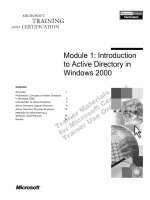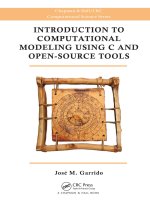Introduction to Design Patterns in C# pot
Bạn đang xem bản rút gọn của tài liệu. Xem và tải ngay bản đầy đủ của tài liệu tại đây (5.24 MB, 424 trang )
Copyright © , 2002 by James W Cooper
Introduction to Design Patterns in C#
Copyright © 2002 by James W. Cooper
IBM T J Watson Research Center
February 1, 2002
Copyright © , 2002 by James W Cooper
2
1. What are Design Patterns? 21
Defining Design Patterns 23
The Learning Process 25
Studying Design Patterns 26
Notes on Object-Oriented Approaches 26
C# Design Patterns 27
How This Book Is Organized 28
2. Syntax of the C# Language 29
Data Types 30
Converting Between Numbers and Strings 32
Declaring Multiple Variables 32
Numeric Constants 32
Character Constants 33
Variables 33
Declaring Variables as You Use Them 34
Multiple Equals Signs for Initialization 34
A Simple C# Program 34
Compiling & Running This Program 36
Arithmetic Operators 36
Increment and Decrement Operators 37
Combining Arithmetic and Assignment Statements 37
Making Decisions in C# 38
Comparison Operators 39
Copyright © , 2002 by James W Cooper
3
Combining Conditions 39
The Most Common Mistake 40
The switch Statement 41
C# Comments 41
The Ornery Ternary Operator 42
Looping Statements in C# 42
The while Loop 42
The do-while Statement 43
The for Loop 43
Declaring Variables as Needed in For Loops 44
Commas in for Loop Statements 44
How C# Differs From C 45
Summary 46
3. Writing Windows C# Programs 47
Objects in C# 47
Managed Languages and Garbage Collection 48
Classes and Namespaces in C# 48
Building a C# Application 49
The Simplest Window Program in C# 50
Windows Controls 54
Labels 55
TextBox 55
CheckBox 56
Copyright © , 2002 by James W Cooper
4
Buttons 56
Radio buttons 56
Listboxes and Combo Boxes 57
The Items Collection 57
Menus 58
ToolTips 58
Other Windows Controls 59
The Windows Controls Program 59
Summary 61
Programs on the CD-ROM 47
4. Using Classes and Objects in C# 62
What Do We Use Classes For? 62
A Simple Temperature Conversion Program 62
Building a Temperature Class 64
Converting to Kelvin 67
Putting the Decisions into the Temperature Class 67
Using Classes for Format and Value Conversion 68
Handling Unreasonable Values 71
A String Tokenizer Class 71
Classes as Objects 73
Class Containment 75
Initialization 76
Classes and Properties 77
Copyright © , 2002 by James W Cooper
5
Programming Style in C# 79
Summary 80
Programs on the CD-ROM 62
5. Inheritance 81
Constructors 81
Drawing and Graphics in C# 82
Using Inheritance 84
Namespaces 85
Creating a Square From a Rectangle 86
Public, Private and Protected 88
Overloading 89
Virtual and Override Keywords 89
Overriding Methods in Derived Classes 90
Replacing Methods Using New 91
Overriding Windows Controls 92
Interfaces 94
Abstract Classes 95
Comparing Interfaces and Abstract Classes 97
Summary 99
Programs on the CD-ROM 99
6. UML Diagrams 100
Inheritance 102
Interfaces 103
Copyright © , 2002 by James W Cooper
6
Composition 103
Annotation 105
WithClass UML Diagrams 106
C# Project Files 106
7. Arrays, Files and Exceptions in C# 107
Arrays 107
Collection Objects 108
ArrayLists 108
Hashtables 109
SortedLists 110
Exceptions 110
Multiple Exceptions 112
Throwing Exceptions 113
File Handling 113
The File Object 113
Reading Text File 114
Writing a Text File 114
Exceptions in File Handling 114
Testing for End of File 115
A csFile Class 116
8. The Simple Factory Pattern 121
How a Simple Factory Works 121
Sample Code 122
Copyright © , 2002 by James W Cooper
7
The Two Derived Classes 122
Building the Simple Factory 123
Using the Factory 124
Factory Patterns in Math Computation 125
Programs on the CD-ROM 128
Thought Questions 128
9. The Factory Method 129
The Swimmer Class 132
The Events Classes 132
Straight Seeding 133
Circle Seeding 134
Our Seeding Program 134
Other Factories 135
When to Use a Factory Method 136
Thought Question 136
Programs on the CD-ROM 136
10. The Abstract Factory Pattern 137
A GardenMaker Factory 137
The PictureBox 141
Handling the RadioButton and Button Events 142
Adding More Classes 143
Consequences of Abstract Factory 144
Thought Question 144
Copyright © , 2002 by James W Cooper
8
Programs on the CD-ROM 144
11. The Singleton Pattern 145
Creating Singleton Using a Static Method 145
Exceptions and Instances 146
Throwing the Exception 147
Creating an Instance of the Class 147
Providing a Global Point of Access to a Singleton 148
Other Consequences of the Singleton Pattern 149
Programs on Your CD-ROM 149
12. The Builder Pattern 150
An Investment Tracker 151
The Stock Factory 154
The CheckChoice Class 155
The ListboxChoice Class 156
Using the Items Collection in the ListBox Control 157
Plotting the Data 158
The Final Choice 159
Consequences of the Builder Pattern 160
Thought Questions 161
Programs on the CD-ROM 161
13. The Prototype Pattern 162
Cloning in C# 163
Using the Prototype 163
Copyright © , 2002 by James W Cooper
9
Cloning the Class 167
Using the Prototype Pattern 170
Dissimilar Classes with the Same Interface 172
Prototype Managers 176
Consequences of the Prototype Pattern 176
Thought Question 177
Programs on the CD-ROM 177
Summary of Creational Patterns 178
14. The Adapter Pattern 180
Moving Data Between Lists 180
Making an Adapter 182
Using the DataGrid 183
Detecting Row Selection 186
Using a TreeView 186
The Class Adapter 188
Two-Way Adapters 190
Object Versus Class Adapters in C# 190
Pluggable Adapters 191
Thought Question 191
Programs on the CD-ROM 191
15. The Bridge Pattern 192
The VisList Classes 195
The Class Diagram 196
Copyright © , 2002 by James W Cooper
10
Extending the Bridge 197
Windows Forms as Bridges 201
Consequences of the Bridge Pattern 202
Thought Question 203
Programs on the CD-ROM 203
16. The Composite Pattern 204
An Implementation of a Composite 205
Computing Salaries 206
The Employee Classes 206
The Boss Class 209
Building the Employee Tree 210
Self-Promotion 213
Doubly Linked Lists 213
Consequences of the Composite Pattern 215
A Simple Composite 215
Composites in .NET 216
Other Implementation Issues 216
Thought Questions 216
Programs on the CD-ROM 217
17. The Decorator Pattern 218
Decorating a CoolButton 218
Handling events in a Decorator 220
Layout Considerations 221
Copyright © , 2002 by James W Cooper
11
Control Size and Position 221
Multiple Decorators 222
Nonvisual Decorators 225
Decorators, Adapters, and Composites 226
Consequences of the Decorator Pattern 226
Thought Questions 226
Programs on the CD-ROM 227
18. The Façade Pattern 228
What Is a Database? 228
Getting Data Out of Databases 230
Kinds of Databases 231
ODBC 232
Database Structure 232
Using ADO.NET 233
Connecting to a Database 233
Reading Data from a Database Table 234
dtable = dset.Tables [0]; 235
Executing a Query 235
Deleting the Contents of a Table 235
Adding Rows to Database Tables Using ADO.NET 236
Building the Façade Classes 237
Building the Price Query 239
Making the ADO.NET Façade 239
Copyright © , 2002 by James W Cooper
12
The DBTable class 242
Creating Classes for Each Table 244
Building the Price Table 246
Loading the Database Tables 249
The Final Application 251
What Constitutes the Façade? 252
Consequences of the Façade 253
Thought Question 253
Programs on the CD-ROM 253
19. The Flyweight Pattern 254
Discussion 255
Example Code 256
The Class Diagram 261
Selecting a Folder 261
Handling the Mouse and Paint Events 263
Flyweight Uses in C# 264
Sharable Objects 265
Copy-on-Write Objects 265
Thought Question 266
Programs on the CD-ROM 266
20. The Proxy Pattern 267
Sample Code 268
Proxies in C# 270
Copyright © , 2002 by James W Cooper
13
Copy-on-Write 271
Comparison with Related Patterns 271
Thought Question 271
Programs on the CD-ROM 271
21. Chain of Responsibility 274
Applicability 275
Sample Code 276
The List Boxes 280
Programming a Help System 282
Receiving the Help Command 286
A Chain or a Tree? 287
Kinds of Requests 289
Examples in C# 289
Consequences of the Chain of Responsibility 290
Thought Question 290
Programs on the CD-ROM 291
22. The Command Pattern 292
Motivation 292
Command Objects 293
Building Command Objects 294
Consequences of the Command Pattern 297
The CommandHolder Interface 297
Providing Undo 301
Copyright © , 2002 by James W Cooper
14
Thought Questions 309
Programs on the CD-ROM 310
23. The Interpreter Pattern 311
Motivation 311
Applicability 311
A Simple Report Example 312
Interpreting the Language 314
Objects Used in Parsing 315
Reducing the Parsed Stack 319
Implementing the Interpreter Pattern 321
The Syntax Tree 322
Consequences of the Interpreter Pattern 326
Thought Question 327
Programs on the CD-ROM 327
24. The Iterator Pattern 328
Motivation 328
Sample Iterator Code 329
Fetching an Iterator 330
Filtered Iterators 331
The Filtered Iterator 331
Keeping Track of the Clubs 334
Consequences of the Iterator Pattern 335
Programs on the CD-ROM 336
Copyright © , 2002 by James W Cooper
15
25. The Mediator Pattern 337
An Example System 337
Interactions Between Controls 339
Sample Code 341
Initialization of the System 345
Mediators and Command Objects 345
Consequences of the Mediator Pattern 347
Single Interface Mediators 348
Implementation Issues 349
Programs on the CD-ROM 349
26. The Memento Pattern 350
Motivation 350
Implementation 351
Sample Code 351
A Cautionary Note 358
Command Objects in the User Interface 358
Handling Mouse and Paint Events 360
Consequences of the Memento 361
Thought Question 361
Programs on the CD-ROM 362
27. The Observer Pattern 363
Watching Colors Change 364
The Message to the Media 367
Copyright © , 2002 by James W Cooper
16
Consequences of the Observer Pattern 368
Programs on the CD-ROM 369
28. The State Pattern 370
Sample Code 370
Switching Between States 376
How the Mediator Interacts with the State Manager 377
The ComdToolBarButton 378
Handling the Fill State 381
Handling the Undo List 382
The VisRectangle and VisCircle Classes 385
Mediators and the God Class 387
Consequences of the State Pattern 388
State Transitions 388
Thought Questions 389
Programs on the CD-ROM 389
29. The Strategy Pattern 390
Motivation 390
Sample Code 391
The Context 392
The Program Commands 393
The Line and Bar Graph Strategies 394
Drawing Plots in C# 394
Making Bar Plots 395
Copyright © , 2002 by James W Cooper
17
Making Line Plots 396
Consequences of the Strategy Pattern 398
Programs on the CD-ROM 398
30. The Template Method Pattern 399
Motivation 399
Kinds of Methods in a Template Class 401
Sample Code 402
Drawing a Standard Triangle 404
Drawing an Isosceles Triangle 404
The Triangle Drawing Program 405
Templates and Callbacks 406
Summary and Consequences 407
Programs on the CD-ROM 408
31. The Visitor Pattern 409
Motivation 409
When to Use the Visitor Pattern 411
Sample Code 411
Visiting the Classes 413
Visiting Several Classes 414
Bosses Are Employees, Too 416
Catch-All Operations with Visitors 417
Double Dispatching 419
Why Are We Doing This? 419
Copyright © , 2002 by James W Cooper
18
Traversing a Series of Classes 419
Consequences of the Visitor Pattern 420
Thought Question 420
Programs on the CD-ROM 421
32. Bibliography 422
Copyright © , 2002 by James W Cooper
19
Preface
This is a practical book that tells you how to write C# programs using
some of the most common design patterns. It also serves as a quick
introduction to programming in the new C# language. The pattern
discussions are structured as a series of short chapters, each describing a
design pattern and giving one or more complete working, visual example
programs that use that pattern. Each chapter also includes UML diagrams
illustrating how the classes interact.
This book is not a "companion" book to the well-known Design Patterns
text. by the "Gang of Four." Instead, it is a tutorial for people who want to
learn what design patterns are about and how to use them in their work.
You do not have to have read Design Patterns to read this book, but when
you are done here you may well want to read or reread it to gain additional
insights.
In this book, you will learn that design patterns are frequently used ways
of organizing objects in your programs to make them easier to write and
modify. You’ll also see that by familiarizing yourself with them, you’ve
gained some valuable vocabulary for discussing how your programs are
constructed.
People come to appreciate design patterns in different ways—from the
highly theoretical to the intensely practical—and when they finally see the
great power of these patterns, an “Aha!” moment occurs. Usually this
moment means that you suddenly have an internal picture of how that
pattern can help you in your work.
In this book, we try to help you form that conceptual idea, or gestalt, by
describing the pattern in as many ways as possible. The book is organized
into six main sections: an introductory description, an introduction to C#,
and descriptions of patterns, grouped as creational, structural, and
behavioral.
Copyright © , 2002 by James W Cooper
20
For each pattern, we start with a brief verbal description and then build
simple example programs. Each of these examples is a visual program that
you can run and examine to make the pattern as concrete a concept as
possible. All of the example programs and their variations are on the
companion CD-ROM, where you run them, change them, and see how the
variations you create work.
Since each of the examples consists of a number of C# files for each of the
classes we use in that example, we provide a C# project file for each
example and place each example in a separate subdirectory to prevent any
confusion. This book is based on the Beta-2 release of Visual Studio.Net.
Any changes between this version and the final product will probably not
be great. Consult the Addison-Wesley website for updates to any example
code.
If you leaf through the book, you’ll see screen shots of the programs we
developed to illustrate the design patterns, providing yet another way to
reinforce your learning of these patterns. In addition, you’ll see UML
diagrams of these programs, illustrating the interactions between classes in
yet another way. UML diagrams are just simple box and arrow
illustrations of classes and their inheritance structure, where arrows point
to parent classes, and dotted arrows point to interfaces. And if you’re not
yet familiar with UML, we provide a simple introduction in the second
chapter.
When you finish this book, you’ll be comfortable with the basics of design
patterns and will be able to start using them in your day-to-day C#
programming work.
James W. Cooper
Nantucket, MA
Wilton, CT
Kona, HI
Copyright © , 2002 by James W Cooper
21
1. What are Design Patterns?
Sitting at your desk in front of your workstation, you stare into space,
trying to figure out how to write a new program feature. You know
intuitively what must be done, what data and what objects come into play,
but you have this underlying feeling that there is a more elegant and
general way to write this program.
In fact, you probably don’t write any code until you can build a picture in
your mind of what the code does and how the pieces of the code interact.
The more that you can picture this “organic whole,” or gestalt, the more
likely you are to feel comfortable that you have developed the best
solution to the problem. If you don’t grasp this whole right away, you may
keep staring out the window for a time, even though the basic solution to
the problem is quite obvious.
In one sense you feel that the more elegant solution will be more reusable
and more maintainable, but even if you are the sole likely programmer,
you feel reassured once you have designed a solution that is relatively
elegant and that doesn’t expose too many internal inelegancies.
One of the main reasons that computer science researchers began to
recognize design patterns is to satisfy this need for elegant, but simple,
reusable solutions. The term “design patterns” sounds a bit formal to the
uninitiated and can be somewhat offputting when you first encounter it.
But, in fact, design patterns are just convenient ways of reusing object-
oriented code between projects and between programmers. The idea
behind design patterns is simple—write down and catalog common
interactions between objects that programmers have frequently found
useful.
One of the frequently cited patterns from early literature on programming
frameworks is the Model-View-Controller framework for Smalltalk
(Krasner and Pope 1988), which divided the user interface problem into
three parts, as shown in Figure 1-1. The parts were referred to as a data
Copyright © , 2002 by James W Cooper
22
model, which contains the computational parts of the program; the view,
which presented the user interface; and the controller, which interacted
between the user and the view.
View
Controller
Data Model
Figure 1-1 – The Model-View-Controller framework
Each of these aspects of the problem is a separate object, and each has its
own rules for managing its data. Communication among the user, the GUI,
and the data should be carefully controlled, and this separation of
functions accomplished that very nicely. Three objects talking to each
other using this restrained set of connections is an example of a powerful
design pattern.
In other words, design patterns describe how objects communicate without
become entangled in each other’s data models and methods. Keeping this
separation has always been an objective of good OO programming, and if
you have been trying to keep objects minding their own business, you are
probably using some of the common design patterns already.
Design patterns began to be recognized more formally in the early 1990s
by Erich Gamma (1992), who described patterns incorporated in the GUI
application framework, ET++. The culmination of these discussions and a
number of technical meetings was the publication of the parent book in
this series, Design Patterns—Elements of Reusable Software, by Gamma,
Helm, Johnson, and Vlissides (1995). This book, commonly referred to as
the Gang of Four, or “GoF,” book, has had a powerful impact on those
seeking to understand how to use design patterns and has become an all-
Copyright © , 2002 by James W Cooper
23
time bestseller. It describes 23 commonly occurring and generally useful
patterns and comments on how and when you might apply them. We will
refer to this groundbreaking book as Design Patterns throughout this
book.
Since the publication of the original Design Patterns text, there have been
a number of other useful books published. One closely related book is The
Design Patterns Smalltalk Companion (Alpert, Brown, and Woolf 1998),
which covers the same 23 patterns from the Smalltalk point of view. We’ll
refer to this book throughout as the Smalltalk Companion. Finally, we
recently published Java Design Patterns: a Tutorial, and Visual Basic
Design Patterns, which illustrate all of these patterns in those languages.
Defining Design Patterns
We all talk about the way we do things in our jobs, hobbies, and home life,
and we recognize repeating patterns all the time.
• Sticky buns are like dinner rolls, but I add brown sugar and nut filling
to them.
• Her front garden is like mine, but I grow astilbe in my garden.
• This end table is constructed like that one, but in this one, there are
doors instead of drawers.
We see the same thing in programming when we tell a colleague how we
accomplished a tricky bit of programming so he doesn’t have to recreate it
from scratch. We simply recognize effective ways for objects to
communicate while maintaining their own separate existences.
Some useful definitions of design patterns have emerged as the literature
in this field has expanded.
• “Design patterns are recurring solutions to design problems you see
over and over.” (The Smalltalk Companion)
Copyright © , 2002 by James W Cooper
24
• “Design patterns constitute a set of rules describing how to accomplish
certain tasks in the realm of software development.” (Pree 1994)
• “Design patterns focus more on reuse of recurring architectural design
themes, while frameworks focus on detailed design and
implementation.” (Coplien and Schmidt 1995)
• “A pattern addresses a recurring design problem that arises in specific
design situations and presents a solution to it.” (Buschmann et al.
1996)
• “Patterns identify and specify abstractions that are above the level of
single classes and instances, or of components.” (Gamma et al., 1993)
But while it is helpful to draw analogies to architecture, cabinet making,
and logic, design patterns are not just about the design of objects but about
the interaction between objects. One possible view of some of these
patterns is to consider them as communication patterns.
Some other patterns deal not just with object communication but with
strategies for object inheritance and containment. It is the design of
simple, but elegant, methods of interaction that makes many design
patterns so important.
Design patterns can exist at many levels from very low-level specific
solutions to broadly generalized system issues. There are now hundreds of
patterns in the literature. They have been discussed in articles and at
conferences of all levels of granularity. Some are examples that apply
widely, and a few writers have ascribed pattern behavior to class
groupings that apply to just a single problem (Kurata 1998).
It has become apparent that you don’t just write a design pattern off the
top of your head. In fact, most such patterns are discovered rather than
written. The process of looking for these patterns is called “pattern
mining,” and it is worthy of a book of its own.
The 23 design patterns selected for inclusion in the original Design
Patterns book were those that had several known applications and that
Copyright © , 2002 by James W Cooper
25
were on a middle level of generality, where they could easily cross
application areas and encompass several objects.
The authors divided these patterns into three types: creational, structural,
and behavioral.
• Creational patterns create objects for you rather than having you
instantiate objects directly. This gives your program more flexibility in
deciding which objects need to be created for a given case.
• Structural patterns help you compose groups of objects into larger
structures, such as complex user interfaces or accounting data.
• Behavioral patterns help you define the communication between
objects in your system and how the flow is controlled in a complex
program.
We’ll be looking at C# versions of these patterns in the chapters that
follow, and we will provide at least one complete C# program for each of
the 23 patterns. This way you can examine the code snippets we provide
and also run, edit, and modify the complete working programs on the
accompanying CD-ROM. You’ll find a list of all the programs on the CD-
ROM at the end of each pattern description.
The Learning Process
We have found that regardless of the language, learning design patterns is
a multiple-step process.
1. Acceptance
2. Recognition
3. Internalization
First, you accept the premise that design patterns are important in your
work. Then, you recognize that you need to read about design patterns in
order to know when you might use them. Finally, you internalize the









